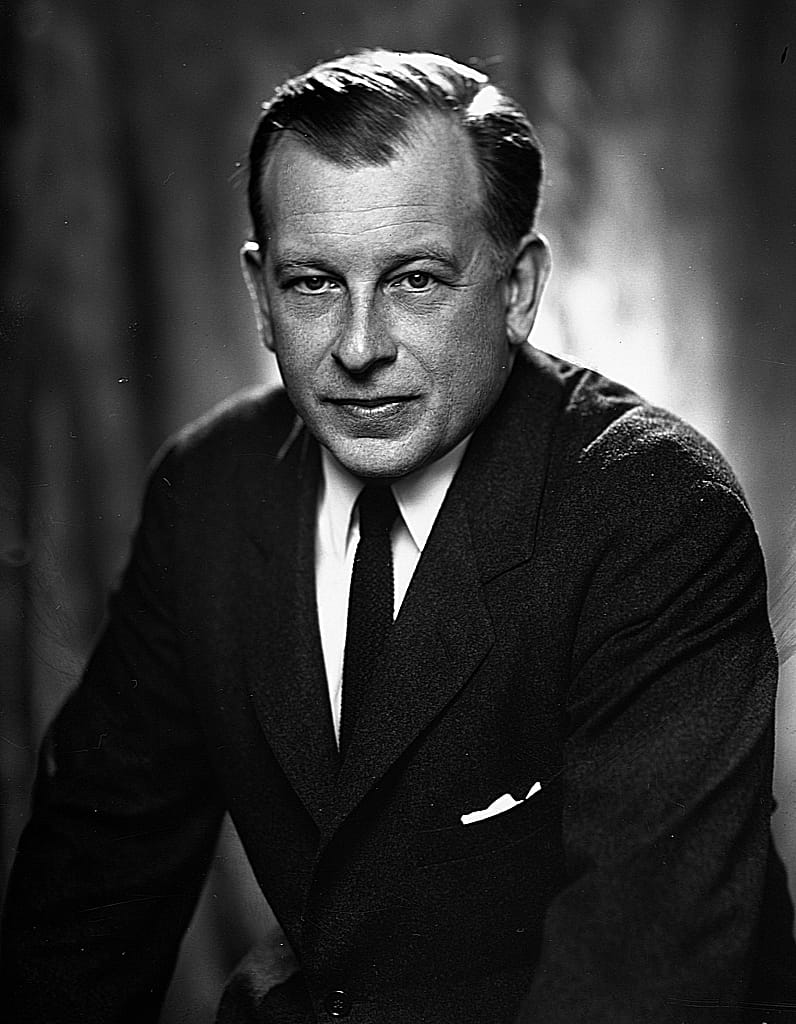Eero Saarinen: The Sculptor of American Modernity
Eero Saarinen, an iconic designer and architect, is renowned for his organic designs, which seamlessly blend form and function.
In the 1950s, as America discovered its triumphant industrial power, one man was sketching the future with the fluidity of a sculptural gesture. Eero Saarinen (1910–1961) embodied that generation of creators who transformed modernist utopia into tangible reality: from airport terminals with bird-like curves in flight to single-pedestal chairs that revolutionized our interiors. In twenty-five years of dazzling creation, this Finnish architect’s son imposed an organic vision of design, reconciling technical performance with formal poetry.
Eero Saarinen, a major figure in 20th-century design and architecture, rejected the orthodoxy of the “International Style.” He instead championed a variable-geometry modernity, where each project dictated its own unique formal logic. The result was a brief yet decisive body of work that profoundly shaped 1960s design and continues to influence our contemporary design imagination today.
The Emergence of a Visionary: Between Family Heritage and American Revolution
At the Sources of Excellence: The Cranbrook School
The story begins in 1923, when young Eero, aged thirteen, accompanied his family into American exile. His father, Eliel Saarinen, an internationally renowned architect, had just narrowly lost the competition for the Chicago Tribune Tower, but this “defeat” opened America’s doors to him. The family settled in Michigan, where Eliel took over the direction of the Cranbrook Academy of Art, transforming this institution into a laboratory of American modernity.
For Eero, growing up at Cranbrook meant being immersed in a universe where art, craft, and industry naturally converged. His mother, Loja Saarinen, a talented textile designer, instilled in him a sense of material and color. In the family workshops, between passionate discussions and models under construction, an approach to design as a synthesis of the arts was forged.
After studying sculpture in Paris – a formative experience that nurtured his three-dimensional understanding of space – then architecture at Yale, Eero returned to the fold. At Cranbrook, he now rubbed shoulders with Charles and Ray Eames, Florence Knoll, Harry Bertoia: a generation that would revolutionize American design. These years of creative incubation (1936-1940) outlined the contours of a new modernity, less dogmatic than its European predecessors, more attentive to comfort and sensuality.
1940: The MoMA Revelation
In 1940, the turning point emerged. The Museum of Modern Art in New York launched an organic furniture competition. Eero Saarinen partnered with Charles Eames to propose revolutionary seating: molded plywood shells, forms embracing human anatomy, fluid aesthetics breaking with the angularity of International Style. Their victory consecrated a new approach to design, where industrial technology served a humanistic vision of comfort.
This foundational collaboration revealed the Saarinen method: start with use to invent form, master industrial materials to create new aesthetic languages. Design was no longer just function; it became the expression of a modern art of living.
The Furniture Oeuvre: When Function Embraces Beauty
Womb Chair (1946-1948): The Modernist Embrace
Emerging from the war, America aspired to new domestic comfort. Florence Knoll, who had become artistic director of the family business, commissioned Saarinen for “a chair in which one could curl up.” His response overturned conventions: the Womb Chair abandoned right angles for an enveloping shell, padded with foam and upholstered in fabric, set on a tubular chromed steel base.
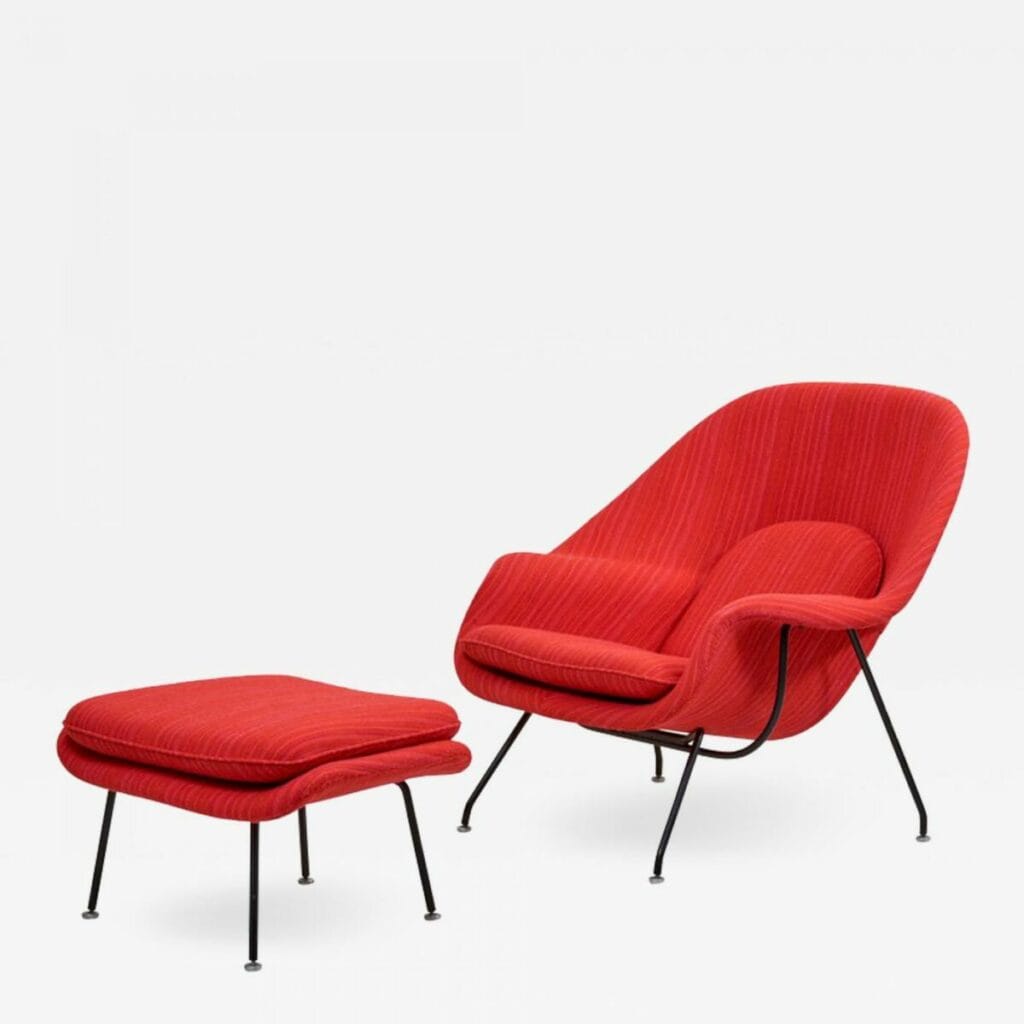
This “womb-chair” – as its detractors nicknamed it – revolutionized modern seating ergonomics. Where Bauhaus creators favored geometric rigor, Saarinen invented a sensual modernity, attentive to physical and psychological well-being. Success was immediate: the Womb Chair became the icon of a cultured bourgeoisie wishing to reconcile aesthetic avant-garde with refined lifestyle.
Tulip Chair (1955-1956): The Pinnacle of Space Age Design
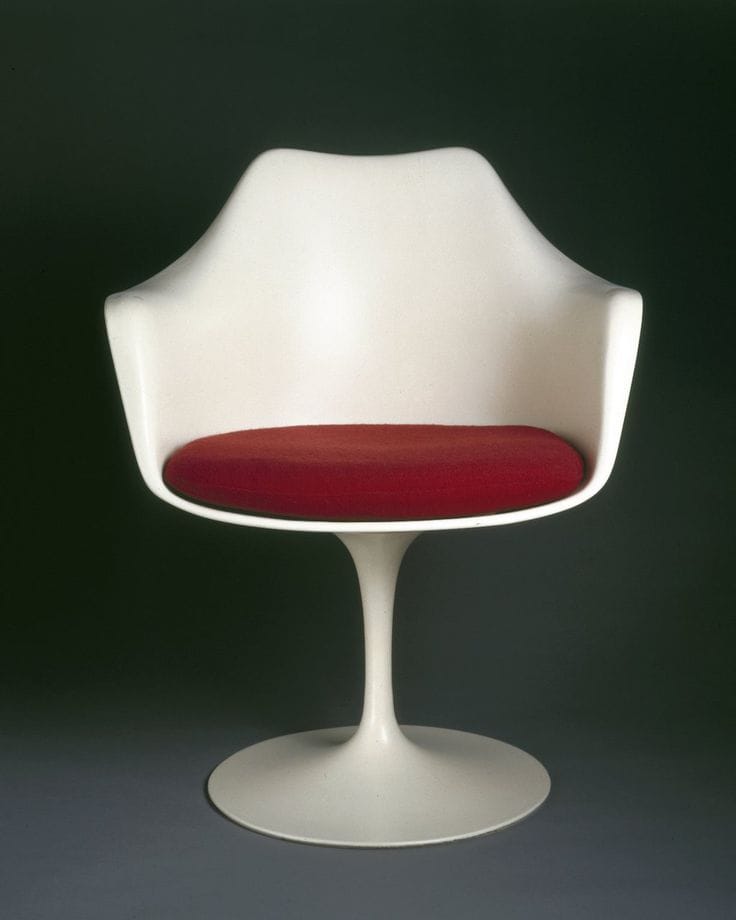
In 1955, Saarinen reached creative maturity with his Pedestal Collection, dominated by the legendary Tulip Chair. His obsession: “eliminate the clutter of legs” that encumbered space under tables and chairs. His revolutionary solution was plastic genius: a flared central base in cast aluminum supporting a fiberglass seat shell, the whole unified by white paint simulating a monobloc.
This chair-sculpture embodied the “Space Age” spirit of the 1950s: fluid lines, high-tech materials, futuristic silhouette evoking both space conquest and domestic elegance. Presented in 1956, it aroused enthusiasm from critics and the public, instantly becoming the archetype of modern furniture. Its production continues today without modification, proof of the accuracy of its proportions and the timelessness of its concept.
Pedestal Table (1957-1958): Perfect Geometry
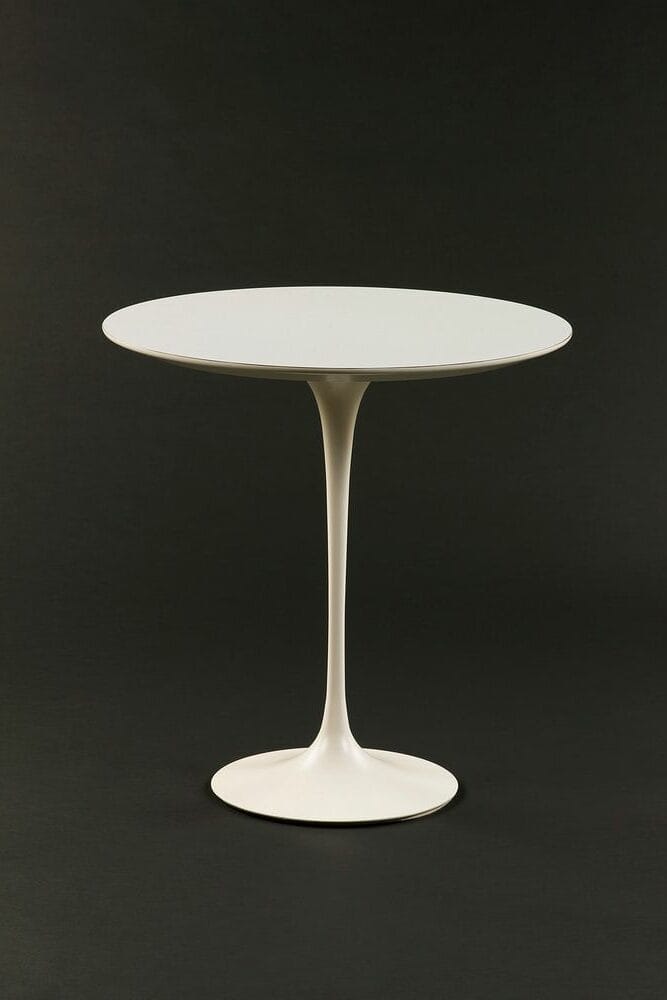
Natural complement to the Tulip chairs, the Pedestal table applied the same central base philosophy to the work surface. Round or oval top – Carrara marble, white laminate, or precious wood – set on a flared aluminum base: the simplicity of the concept masked remarkable technical sophistication.
This table revolutionized domestic and professional layout. By freeing leg space, it authorized free placement of diners and created new sociability around the table. From bourgeois dining rooms to corporate lobbies, it established itself as the symbol of democratic and refined modernity.
Expressive Architecture: When Buildings Take Flight
General Motors Technical Center (1956): Industrial Versailles
In 1945, General Motors entrusted Saarinen with designing its new technical center near Detroit. The challenge was colossal: create an automotive research campus embodying American technological power. His response: a complex of modernist pavilions distributed around an artificial lake, mixing glass transparency, steel rigor, and warmth of colored glazed brick.
This “industrial Versailles” set standards for American corporate design for decades. Each function found its architectural expression: spectacular exhibition halls, modular design offices, technical testing centers. The complex, delivered in 1956, aroused international admiration and established Saarinen as master of corporate architecture.
TWA Flight Center, JFK (1956-1962): The Poetry of Flight
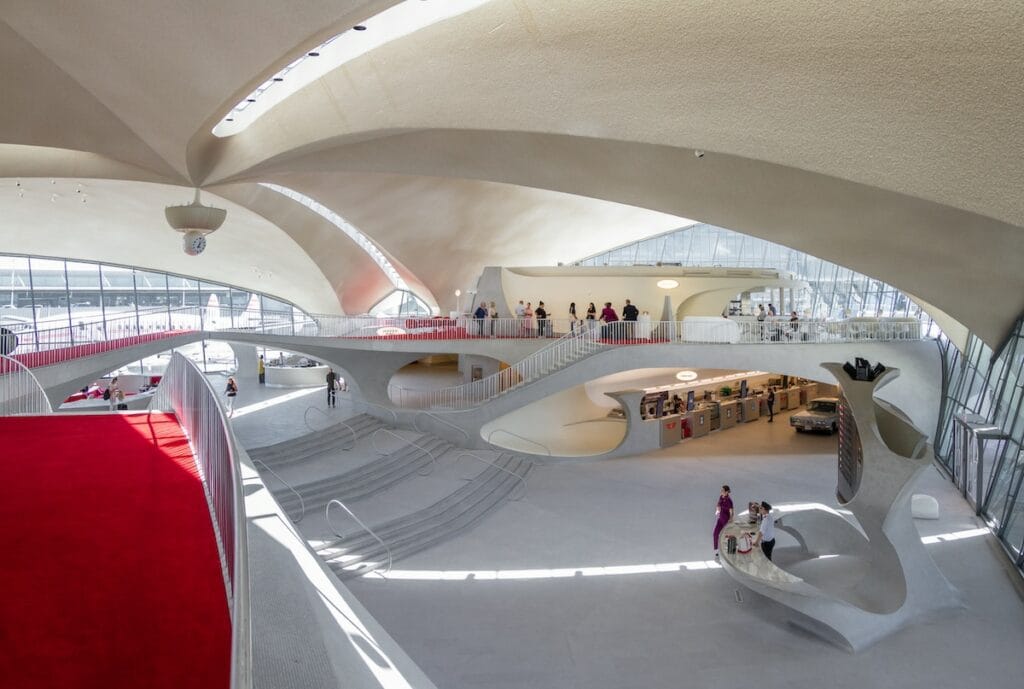
Saarinen’s most famous architectural work was born from a Trans World Airlines commission for its new terminal at John F. Kennedy Airport in New York. Inaugurated in 1962, one year after its creator’s premature death, the TWA Flight Center transcended utilitarian function to become a poetic manifesto of the aeronautical era.
The four thin concrete shells composing the roof evoke a bird with outstretched wings, ready to soar skyward. Inside, fluid space abolishes traditional partitions: floors, walls, and ceilings interpenetrate in continuous sculptural movement. Red TWA walkways snake like arteries, guiding travelers in a choreography of movement.
More than a terminal, Saarinen created a “dream machine” that transformed waiting into aesthetic experience. Closed in 2001, the building is reborn today as a hotel-museum, preserved testimony to the golden age of commercial aviation.
The Saarinen Method: Sculpting Modern Space
Unlike his contemporaries attached to a recognizable style, Saarinen developed a chameleon approach: each project generated its own formal logic. His method was more akin to a sculpture studio than a traditional design office. Iterative models, obsessive search for the right profile, fine articulation between load-bearing structure and expressive envelope: everything contributed to creating unprecedented forms, justified by their specific use.
“The undercarriage of chairs and tables creates an ugly, restless, unrestful world… I wanted to clear up the slum of legs.”
This declaration reveals the essence of his philosophy: purify modern space of its visual slag to reveal the intrinsic beauty of function. In furniture, this produced the central base that unified chair and table in a unique sculptural gesture. In architecture, this produced continuous volumes, carried by frank structures – thin shells, monumental arches, large porticoes – that expressed their constructive logic.
Saarinen mastered the industrial materials of his era – reinforced concrete, steel, aluminum, fiberglass – not to exhibit their modernity, but to make them express new poetry. His genius consisted in reconciling technical performance with aesthetic emotion, creating objects and spaces that touch as much as they function.
The Saarinen Market: Between Heritage and Investment
Seventy years after their creation, Eero Saarinen’s pieces navigate between heritage status and investment value. The market divides into three distinct segments: contemporary reissues, vintage period pieces, and the ultra-rare prototypes or special versions that reach peaks at international auctions.
Knoll Reissues: Perpetuated Industrial Excellence
Knoll International continues to produce Saarinen classics in scrupulous respect of original drawings. This fidelity has a price: a new Tulip chair sells for between $1,300 and $2,000 depending on finishes (fabric or leather cushion, lacquered or polished aluminum base). The Pedestal table ranges from $2,800 to $9,000 depending on diameter and top material – Carrara marble reaching the highest prices.
The Womb Chair, more complex to produce with its sophisticated upholstery, is priced between $3,800 and $6,000 for the complete chair and ottoman set. These prices reflect high-quality artisanal manufacturing: each piece requires several weeks of production, from aluminum casting to final assembly.
The Vintage Market: Quest for Authenticity
Period pieces, produced between 1950 and 1980, seduce collectors and enthusiasts with their authentic patina and manufacturing details sometimes different from current reissues. A vintage Tulip chair in excellent condition sells for between $900 and $1,700, often comparable to new prices but with the aura of history.
Vintage Pedestal tables experience strong demand, particularly 1960s-70s models with original marble tops. Depending on condition and rarity, prices oscillate between $2,200 and $6,500. Collectors particularly seek early runs with “Knoll Associates” labels rather than “Knoll International.”
The vintage Womb Chair represents a more delicate investment: wear on upholstery and covering often requires complete restoration. Count between $1,600 and $3,300 for a professionally restored example, a total cost equivalent to new.
Collector Pieces: When Saarinen Becomes Investment
The market summit concerns exceptional pieces: prototypes, limited versions, or examples with documented provenance. In 2023, at Wright Auctions in Chicago, a Tulip chair prototype with wooden base (never mass-produced) reached $85,000. Complete vintage sets – six Tulip chairs with matching table – can exceed $17,000 at prestigious sales.
Pieces that belonged to personalities or adorned famous interiors benefit from considerable added value. Saarinen furniture from Florence Knoll’s own collection, or having furnished a documented architectural project, can multiply its value by three or four.
Expert Advice for Acquisition
For the enlightened amateur: Prioritize new Knoll reissues for daily use. Warranty, consistent quality, and after-sales service sustainability justify the investment. Contemporary finishes (new fabrics, stain treatments) improve usage comfort.
For the collector: Seek vintage pieces with original labels, invoices, or documentation. Beware of unauthorized reproductions, numerous on the market. Authentication by an expert or recognized auction house secures purchase.
For the investor: Focus on complete sets in perfect condition, rare colors (Tulip in red, black, or special finishes), and pieces with documented provenance. The long trend remains bullish, supported by growing institutional recognition of 20th-century design.
Legacy and Posterity: A Visionary’s Influence
Roots of Excellence
Saarinen’s work is rooted in exceptional ground: Scandinavian family heritage (sense of craftsmanship and functionality), the Cranbrook ecosystem (interdisciplinary creative emulation), Parisian sculptural apprenticeship (mastery of three-dimensional space), and American fascination with technological innovation. This unique synthesis explains the originality of his production: neither European nor purely American, but authentically transatlantic.
Contemporary Echo
Sixty years after his premature disappearance, Saarinen’s influence still irrigates contemporary creation. His principles – form derived from function, humanized industrial materials, search for visual refinement – nourish both architecture offices and design studios. From Norman Foster to Zaha Hadid, from Philippe Starck to Marc Newson, all draw from his formal vocabulary and creative method.
More profoundly, Saarinen demonstrated that technical innovation and artistic sensitivity don’t oppose but nourish each other. This lesson remains burning current as design must respond to the ecological and social challenges of the 21st century.
Recognition and Heritage
Institutional recognition accompanied popular success. Fellow of the American Institute of Architects from 1952, Saarinen posthumously received the AIA Gold Medal in 1962, supreme consecration of American architecture. His works joined permanent collections of MoMA, Cooper Hewitt, and major international museums.
More significantly still, his creations continue to live: Knoll International still produces his chairs and tables in scrupulous respect of original drawings, while his buildings, protected as historic monuments, testify to the permanence of his architectural vision.
Epilogue: Sensual Modernity
In twenty-five years of creation, Eero Saarinen reconciled modern functionalism with sensory pleasure and aesthetic emotion. His chairs embrace the body, his tables liberate space, his buildings tell the story of the era that saw them born. This sensual modernity, attentive to humans as much as performance, perhaps constitutes his most precious contribution to design history.
Facing contemporary challenges – sustainability, inclusivity, emerging technologies – Saarinen’s example reminds us that authentic innovation is born from synthesis between technical rigor and creative intuition. His lesson remains: start with use, master technology, and let beauty emerge from functional accuracy. A program still current for 21st-century creators.
Resources and Further Reading
- Saarinen Collection at Knoll: Complete catalog and official pricing
- Wright Auctions: Modern design specialist, regular Saarinen sales
- 1stDibs & Pamono: International platforms for authenticated vintage design
- Gateway Arch National Park: Architecture and Saarinen heritage
- Cranbrook Academy of Art: Archives and exhibitions on Saarinen’s school
Resources
Design Fundamentals
History of Design & Decorative Styles
From baroque salons to the radical lines of the 20th century, this chronological timeline highlights the aesthetic revolutions that have marked our daily environment.
Read the page “History of Design & Decorative Styles”Hart Design Glossary from A to Z
Sabre legs, patina, passementerie, caning… This lexicon gives meaning to the technical and stylistic terms often used in the design world.
Access the Hart Design GlossaryHart Glossary of Design Icons
This glossary lists all the great names in design and decoration in alphabetical order. Discover the creators who have shaped contemporary living art.
Access the Hart Glossary of Design Icons
Digital entrepreneur and craft artisan, I use my unconventional background to share my vision of luxury design and interior decoration — one enriched by craftsmanship, history, and contemporary creation. Since 2012, I have been working daily in my workshop on the shores of Lake Annecy, creating bespoke interiors for discerning decorators and private clients.

